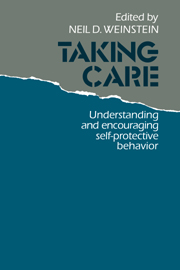Book contents
- Frontmatter
- Contents
- List of contributors
- Acknowledgments
- Introduction: studying self-protective behavior
- I Theoretical perspectives
- II Research and prevention programs for specific hazards
- 6 Why people take precautions against health risks
- 7 Community studies of smoking cessation
- 8 Preventing adolescent smoking
- 9 Natural hazards and precautionary behavior
- 10 Programs that encourage the adoption of precautions against natural hazards: review and evaluation
- 11 Why people take precautions against crime: a review of the literature on individual and collective responses to crime
- 12 Promoting citizen involvement in crime prevention and control
- 13 Injury prevention: limits to self-protective behavior
- 14 Perspectives on protective behaviors and work place hazards
- III Conclusion
- Index
11 - Why people take precautions against crime: a review of the literature on individual and collective responses to crime
Published online by Cambridge University Press: 03 February 2010
- Frontmatter
- Contents
- List of contributors
- Acknowledgments
- Introduction: studying self-protective behavior
- I Theoretical perspectives
- II Research and prevention programs for specific hazards
- 6 Why people take precautions against health risks
- 7 Community studies of smoking cessation
- 8 Preventing adolescent smoking
- 9 Natural hazards and precautionary behavior
- 10 Programs that encourage the adoption of precautions against natural hazards: review and evaluation
- 11 Why people take precautions against crime: a review of the literature on individual and collective responses to crime
- 12 Promoting citizen involvement in crime prevention and control
- 13 Injury prevention: limits to self-protective behavior
- 14 Perspectives on protective behaviors and work place hazards
- III Conclusion
- Index
Summary
Introduction
As crime rates rose steadily in the decades following World War II, a trend toward citizen action to prevent crime developed. Law enforcement officials at all levels of government began to take the position that the police cannot – and should not – be everywhere and that private citizens must play an active role in protecting themselves, their homes, and their communities against crime. One result of this focus on citizen responsibility in crime prevention has been an effort among scholars to delineate the major categories of citizen responses and to investigate the determinants of these responses. The purpose of this chapter is to synthesize and assess what is currently known about responses to crime and the factors influencing these responses.
Three major dimensions of crime response have been identified: cognitive, affective, and behavioral. The cognitive dimension refers to beliefs about crime: about the extent of or change in the crime rate in a specific area (e.g., block, neighborhood, city, or nation), about the crime rate in the neighborhood in comparison with the rest of the city, or about the probability of victimization. Affective responses to crime refer primarily to fear, that is, feelings of threat when one is outside the home during the day or evening and worry or concern about oneself, one's home, or one's family being the target of crime.
- Type
- Chapter
- Information
- Taking CareUnderstanding and Encouraging Self-Protective Behavior, pp. 231 - 253Publisher: Cambridge University PressPrint publication year: 1987
- 4
- Cited by



